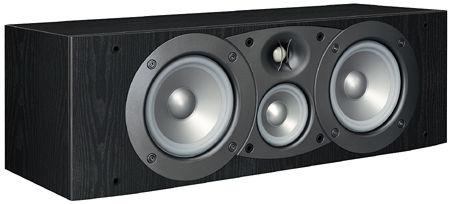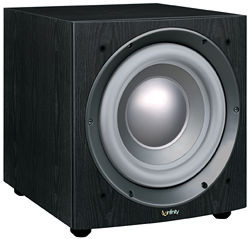Infinity Beta Series Surround Speaker System

Corporate strategy usually calls for applying technological innovation first to high-priced flagship products sold in boutique stores and then eventually have it trickle down to mainstream-priced products sold in the "box" chain stores. Sounds like a reasonable approach, but it doesn't always work.
Sharp tried it with their 1-Bit digital audio technology, beginning with the $15,000 SM-SX100, a gorgeous-looking, superbly built, high-performance 2-channel integrated amplifier, which didn't sell well in audiophile shops because the Sharp name was not associated with high performance audio. Then, when Sharp introduced innovative, compact, budget-priced, DVD-player-equipped, 5.1-channel receivers a few years ago (I reviewed one) utilizing 1-Bit digital amplifiers, they didn't sell well either. Sharp's currently not doing much with their investment other than writing it off.
Harman International's Infinity division seems to be having more luck with their investment in CMMD (Ceramic Metal Matrix Diaphragm) technology, first used in the Prelude MTS. Now, they've incorporated it into the drivers used in the relatively inexpensive Beta series with startlingly effective results.
The goal that drove the development of CMMD was to find a diaphragm material that was both stiff and light like aluminum but, unlike aluminum, did not have a nasty resonant break-up mode at or just above the driver's upper bandpass frequency. Judging by the measurements Harman showed me during a factory visit a few years ago, and based on the fast, open, transparent sound produced by the Prelude MTS and now these far less-expensive Beta speakers, Infinity's ceramic/aluminum "sandwich" CMMD material meets the designers' performance expectations and then some.
Now mass produced in China, the CMMD drivers used in the Beta series no doubt don't have cast baskets or the massive magnet structures and sophisticated, high-power coil assemblies used in Infinity's high-end models, but based on my listening, Harman has clearly retained the benefits of the technology while driving the price points down to almost laughably low levels.
The Beta Rundown
The Beta C360 center-channel speaker (assembled in Mexico) features a pair of 6.5-inch CMMD low-frequency drivers, a 4-inch CMMD midrange, and a 1-inch CMMD tweeter featuring a molded plastic waveguide—all incorporated into a neat, modular fascia at the front of a 34.5 pound, 8.5"x25.75"x11.75" box with an MSRP of just $399. You can expect street prices to be significantly lower—as low as $264 in a Pricegrabber.com search. Now that's downright cheap for what you get physically and sonically.
At that price point, you're usually stuck with a three -driver array with the tweeter placed between a pair of smallish midrange/midbass drivers. Coaxing believable dialog from that configuration is one tough assignment. Many (most) inexpensive centers feature lispy sibilants or a noticeable discontinuity between male chest cavities and voice boxes—not to mention off-axis lobing, which results in uneven frequency response and usually muffled dialog.
 With its relatively large low-frequency drivers surrounding a vertically arrayed midrange/tweeter stack, the C360—a sealed-box design claimed to be 90dB efficient—has the potential to deliver outstanding intelligibility over a wide horizontal window, and it does just that. What's more, it is remarkably free of chesty or sibilant colorations often heard on far more expensive center-channel speakers.
With its relatively large low-frequency drivers surrounding a vertically arrayed midrange/tweeter stack, the C360—a sealed-box design claimed to be 90dB efficient—has the potential to deliver outstanding intelligibility over a wide horizontal window, and it does just that. What's more, it is remarkably free of chesty or sibilant colorations often heard on far more expensive center-channel speakers.
No, the C360 does not have the transparency, delicacy, or "palpability" factor to produce the eerie sensation that an actor is speaking from behind the screen, as do some very expensive center-channel speakers such as Aerial's $4000 CCR-3 or Audio Physic's $5000 Avanti III. But the C360 came remarkably close at less than a tenth of the price. I found film dialog to be articulate, easy to understand, and "forget about it" believable, and that's a major accomplishment for so inexpensive a speaker. There were no obvious mid-bass bumps or high-frequency peaks—just smooth sailing over a wide horizontal window. The better the associated electronics, the better the C360 performs, and I have every confidence it will measure well, with probably a bit of on-axis "presence" region boost.
The left/right speakers in the series range from the diminutive two-way Beta 10 ($165 each) to the floorstanding Beta 50 ($499 each), with models 20 and 40 in between. I chose the $499 floorstanders, which feature magnetically shielded dual 8-inch CMMD woofers, a 5-inch CMMD midrange, and a 1-inch CMMD tweeter. The rear-ported, bi-ampable/bi-wireable Beta 50 weighs a hefty 62.5 pounds and is claimed to have a frequency range of 35hz-20kHz (+/-3dB). All of this for 500 bucks? Are you kidding me?
For the surrounds, I chose the ambitious wall-mountable, bipole/dipole/monopole ES250, which, by removing the strap between the two sets of 5-way binding posts, can also be used centered behind the listening position as a dual-channel EX/ES rear speaker. At $349, the ES250 is, relatively speaking, the most expensive speaker of the bunch, but it's also the most versatile. It features two sets of the same 5-inch midrange/1-inch tweeter array used in the Beta 50, inverted from one another and mounted at a 45° angle in a sealed-box enclosure. Rated eficiency is relatively low at 87dB with claimed response of 60Hz-20kHz (+/-3dB). At the flip of a switch, it is possible to optimize the ES250's performance for movies (dipole) and for 5.1-channel music (bipole).
For the subwoofer, I chose the CSW-10, the smaller of the two deluxe Infinity powered subs offered for this review. Neither of these has Beta in its name, though they're designed to accompany a Beta-based system. At $999 (MSRP), it ups the system price considerably, and given the Beta 50 tower's outstanding bass, you could skimp here are get the considerably less expensive PS12 subwoofer ($450 MPRP), which is said to be good down to 25Hz.
The CSW-10 is a relatively small sealed-box unit featuring a rugged-looking 10-inch CMMD driver with a -3dB response spec'd at a very low 22Hz, driven by a 650W RMS amplifier (at no more than 0.1% THD). Rear-panel facilities include level, variable high-pass filter (50-150Hz), a phase-reversal switch, and Infinity's unique R.A.B.O.S. (Room Adaptive Bass Optimization System) parametric equalizer. Without the use of test equipment other than a simple SPL meter and test CD supplied with the subwoofer, you can determine the width, height, and center frequency of your room's worst bass "bump" and then set the equalizer controls to attenuate or eliminate it.
Using the R.A.B.O.S. system is relatively easy. Among its benefits in a typical living-room-situated home theater system is that you can put the subwoofer in a corner where the missus says it has to go, and then tune out the inevitable bump—at least at the primary listening position. In my living room, with the CSW-10 placed in a corner, R.A.B.0.S. measured a mountainous peak centered at 35Hz. After compensation, the system's bottom end was far smoother and better integrated, yet the very bottom end remained robust and surprisingly extended to well below 30Hz. Surprising because the sub is so small.
No one's going to confuse this system with fine furniture—especially in the black finish my review system sported. Aesthetically, it's best described as utilitarian, though knuckle raps indicate surprisingly well-braced and well-constructed cabinets, especially given the prices.
- Log in or register to post comments




































































